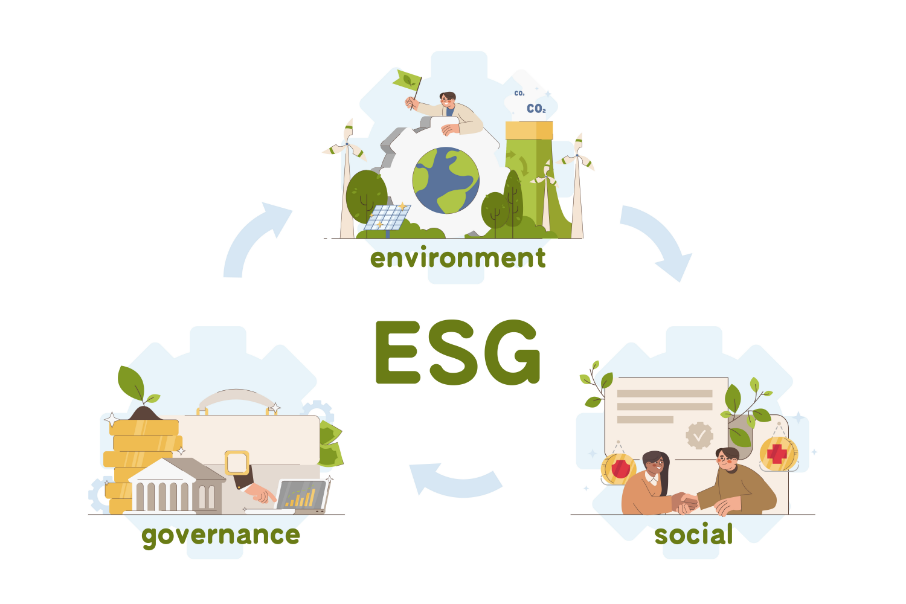
• "By 2030, ESG-driven assets are expected to reach $50 trillion globally. Can Saudi Arabia afford to stay behind?"
As Vision 2030 propels Saudi Arabia towards a diversified, sustainable economy, the pressure is mounting for companies to align with environmental, social, and governance (ESG) frameworks. However, there’s a growing tension between compliance and growth. Many Saudi business leaders wonder: Can we reduce our carbon footprint and still scale aggressively? Or does one come at the cost of the other?
This debate is no longer theoretical. With regulations tightening, especially in manufacturing sectors, and global investors demanding accountability, striking the right balance between ESG compliance and profitability is becoming a boardroom priority.
Let’s break it down.
• What is ESG Compliance? A Simplified Overview
ESG compliance refers to an organization’s efforts to meet standards related to environmental care (E), social responsibility (S), and corporate governance (G).
- Environmental: Reducing emissions, managing waste, and promoting sustainable resource use.
- Social: Ensuring labor rights, community engagement, and diversity.
- Governance: Transparent leadership, ethical decision-making, and regulatory adherence.
In Saudi Arabia, ESG is no longer optional. The Saudi Exchange has mandated ESG disclosures for listed companies, and the Public Investment Fund (PIF) has embedded ESG into its investment criteria.
• Why ESG Matters in the Saudi Market
Saudi Arabia is experiencing a paradigm shift. As oil dependency decreases, sectors like manufacturing, real estate, and logistics are booming. Yet with growth comes scrutiny.
- Carbon footprint reduction Saudi: One of the biggest global expectations is reducing environmental impact. Saudi industries must adopt greener practices to remain competitive.
- Global Investment Appeal: Investors are demanding ESG transparency. Non-compliance could limit access to foreign capital.
- Regulatory Alignment: The Saudi Green Initiative and Vision 2030 underscore the need for sustainability.
Ignoring ESG today could mean being left out of global trade and investment opportunities tomorrow.
• The Challenges: Why Balancing ESG and Growth Isn’t Easy
Despite its importance, integrating ESG into business operations is no easy feat.
- Cost vs. ROI Dilemma
- Upgrading to sustainable technologies can be expensive.
- Many SMEs worry ESG adoption will slow down their momentum.
- Lack of Expertise & Data
- Understanding ESG metrics and reporting standards is complex.
- Companies often lack internal capacity or the tools for ESG tracking.
- Cultural & Operational Resistance
- Traditional management styles may not align with ESG frameworks.
- Change management becomes a challenge in legacy sectors like manufacturing.
• Solutions & Best Practices for Saudi Companies
Rather than choosing one over the other, smart companies are aligning ESG with growth. Here’s how:
- Adopt ESG from the Ground Up
- Embed ESG into your company’s mission, not just as a checkbox activity.
- Train leadership and teams on ESG values.
- Invest in ESG Reporting Tools
- Use digital platforms like CGBOD’s ESG module to simplify data tracking.
- Automate compliance documentation to save time and reduce human error.
- Conduct ESG Audits & Materiality Assessments
- Identify high-impact areas where improvement matters most.
- Focus on material issues that affect both your business and stakeholders.
- Collaborate with Experts
- Work with ESG consultants and compliance officers who understand the Saudi regulatory environment.
- Pilot Sustainable Projects Before Scaling
- Test eco-friendly initiatives in smaller units.
- Measure ROI before implementing large-scale changes.
• ESG in Action: A Saudi Manufacturing Success Story
Let’s explore a real-world case study on how a Saudi manufacturing firm reduced its carbon footprint while growing market share.
Company: AlFanar Manufacturing
Challenge: High emissions from outdated production lines and growing pressure from global partners to comply with ESG standards.
Solution:
- Conducted a carbon audit and identified energy-intensive processes.
- Integrated renewable energy into its facilities.
- Partnered with CGBOD to digitize ESG tracking and streamline reporting.
Results:
- Reduced carbon emissions by 38% in 18 months.
- Secured a $12M international contract due to improved ESG credentials.
- Received recognition from the Ministry of Industry as a sustainability leader.
This ESG success story Saudi proves that sustainable manufacturing Saudi isn’t just possible—it’s profitable.
• Conclusion: The Way Forward for Saudi Businesses
Saudi companies don’t have to choose between growth and ESG. With the right frameworks, tools, and mindset, they can accelerate both. ESG isn’t just about compliance—it’s a competitive advantage.
